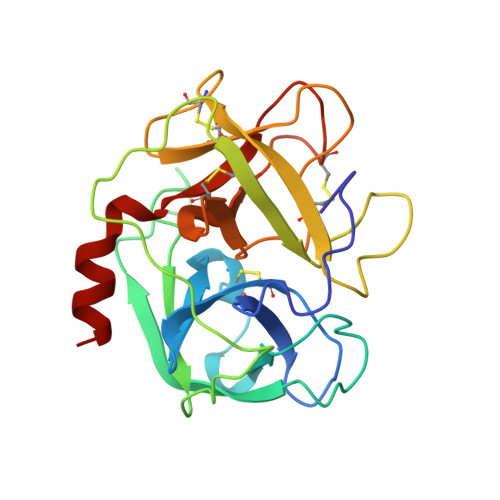The crystal structure of PR3, a neutrophil serine proteinase antigen of Wegener's granulomatosis antibodies.
Fujinaga, M., Chernaia, M.M., Halenbeck, R., Koths, K., James, M.N.(1996) J Mol Biol 261: 267-278
- PubMed: 8757293
- DOI: https://doi.org/10.1006/jmbi.1996.0458
- Primary Citation of Related Structures:
1FUJ - PubMed Abstract:
The crystal structure of PR3, a serine proteinase from the azurophilic granules of human polymorphonuclear neutrophils, has been solved by molecular replacement using the human leukocyte elastase structure. The PR3 structure has been refined to an R-factor (= sigma parallel Fo magnitude of-Fc parallel/sigma magnitude of Fo) of 0.201 for all data in the range of 10.0 to 2.2 A resolution. The enzyme was crystallized in space group P21 with four molecules in the asymmetric unit (Vm approximately equal to 2.6 A/Da). The overall fold consists of two domains of beta-barrel structures typical of the chymotrypsin family of serine proteinases. In general, the substrate binding sites, S4 to S3', are more polar than comparable sites in the related proteinase, human leukocyte elastase. The experimentally observed preference of PR3 for small aliphatic residues at the P1 position of a substrate is explained by the Val to Ile substitution at position 190 when compared to the elastase structure. The substitution of Ala by Asp at position 213 at the back of S1 should not affect its specificity greatly, as the Asp side-chain points back into the interior of the protein. The PR3 structure includes a disaccharide unit (N-linked 2-acetamido-2-deoxy-beta-D-glucopyranose and 1,6-linked alpha-L-fucopyranose) covalently attached to Asn 159. The linear antigenic sites of PR3 reported to react with Wegener's granulomatosis autoantibodies occur in regions of the three-dimensional structure that may implicate the inactive pro-form of the enzyme in the pathogenesis of the disease.
Organizational Affiliation:
Department of Biochemistry, University of Alberta, Edmonton, Canada.















